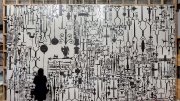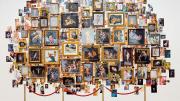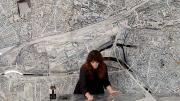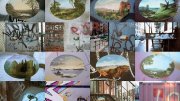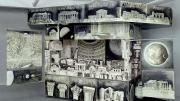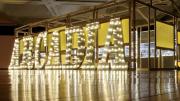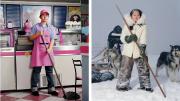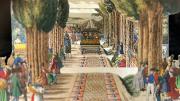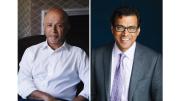Ellen Harvey ’89 is between shows, so most of her work is packed up, the walls of her studio baring their industrial concrete. Only one piece, unfinished, is propped by the entrance: a massive grayscale cityscape. Blending in with its surroundings, it at first resembles a blown-up photograph. Careful scrutiny gradually reveals thin strokes of oil paint, which bring out the window ledges of warehouses and a water tower’s spindly legs; daubs name the trees and clouds. Where most of her work takes the form of multi-part installations, this painting stands alone. But in another sense, it’s a classic Harvey: its power lies in the accumulation of small moments into an overwhelming whole.
Harvey works in other media, but may be best known for her exhaustive collections of paintings about painting: a copy of every nude in Miami’s Bass museum; a miniature version of every work in the Whitney Museum catalog; a portrait of every piece of metalwork in the Barnes Foundation’s collection. The projects are rapturous bordering on obsessive-compulsive, but reducing them to genre-worship would be a mistake. Harvey uses her fascination with traditional art techniques to comment on “art” as an enterprise, and to point out its potential for multiple “failures”—failures to communicate, to preserve, to record, to hold value; she readily acknowledges painting’s potential to become merely “wallpaper for the rich.” This interest in failure derives from her own unconventional start as an artist: Harvey switched careers after attending Yale Law School, and has never studied art formally. Though recognition of her work is growing, and art institutions worldwide seek her out more frequently, she still considers herself something of an outsider in that world.
Her indulgent, delicate style comes from a charmed British upbringing in which painting was “the most glamorous thing imaginable.” She remembers, on a visit to France as a five-year-old, sitting for hours before the Beaune Altarpiece, by the fifteenth-century painter Rogier van der Weyden; her parents left her alone with just the priest and the painting. The glowing, jewel-like colors still enchant her, and it’s this enchantment that she wants to make available to a wider audience. Though the contemporary art world has declared the “death of painting” several times over, many viewers still consider painting “glamorous,” equating it with the rarified history that Harvey’s work references. Skeptical of elitist proclamations, she’s interested in ornamentation as a public good: providing “useless” decorative art to the masses upends the expectations of a transactional consumer culture. So she continues to paint, etch, and make mosaics in service of a “shameless popularism.”
Composed of familiar stylistic quotations, the language of her work is accessible: viewers are put at ease by recognizable tropes like the pastoral landscape and the dignified portrait. But something a little more difficult, slightly acid or off, lurks beneath the surface. Her installations and public pieces “seduce the viewer into thinking,” as she puts it: their pleasant, conservative style keeps their sometimes startling revelations under wraps. “A gift is always a more complicated transaction than it appears,” she says, with a deep belly laugh.
Harvey’s complicated gifts have a way of starting complicated conversations. Her series New York City Beautification Project, completed between 1999 and 2001, interrupted urban grit through guerilla oil painting. She painted palm-sized ovular landscapes, depicting placid fields and bowers, directly onto street signs, graffiti murals, and dumpsters. The images themselves are sweet and innocuous, borrowing from what Harvey calls “the refuge of the Sunday painter,” but the project engaged with the difficult truths of its context. Under New York mayor Rudolph Giuliani’s “tough on crime” programs, Harvey’s profile (as a young white woman with a British accent) lent her an artistic legitimacy unavailable to others. Conversation about the series became heated: critics assumed that she was blindly exercising, rather than attempting to expose, her privilege. The public, meanwhile, became surprisingly invested in the upkeep and preservation of the paintings, which Harvey had intended to be temporary. Her small pictures of rolling green hills proved more controversial than anyone had expected.
Since then, she has targeted art’s privileged institutions more directly. The Nudist Museum’s pile-on of flamingo-pink flesh lampooned the body-obsession at the heart of the history of the classical nude, and of modern Miami culture. A Whitney for the Whitney revealed the absurdities of treating art as a commodity.
Lately, Harvey has taken a gentler approach, in work that offers up the lost, the neglected, the forgotten, and the unloved. A mirrored installation gives glimpses of the paintings collecting dust in museum storerooms in Bruges. Paintings based on the recollections of Hurricane Katrina survivors attempt to restore their lost possessions. A collection of abandoned good-luck charms falsely promises a second chance for Las Vegas gamblers. Explanatory documents detail the absurdist future-history of aliens excavating a fallen Washington, D.C. The prevailing theme seems to be that time and randomness—not a museum—decide what lasts and what fades. But what might depress some artists inspires Harvey: if nothing matters, then everything might. And so with her own work: already prolific, she keeps a running list of 20 to 30 potential projects she’d like to make a reality. There’s no way they’ll all come to be. She finds that “rather lovely.”
Unlike most of her work, the unfinished cityscape in her studio is not meant for public consumption. It will hang in the lobby of the warehouse where she has lived and worked alongside other artist-tenants for two decades and counting, as a gift to her landlord. The actual cityscape is best seen from her building’s roof. There, she reflects and distorts details of the landscape using a Claude glass—a dark, palm-sized convex mirror in a velvet case, an eighteenth-century curio used by landscape painters to parse a scene into light values. Harvey loves Claude glasses: their intimacy, their redundancy, their useless but beguiling ornamentation. “Art is an unreliable mirror, a dark mirror,” she says, focusing hard on the tiny world she holds in her hand. Held at an angle, high and to the side, the glass returns the cityscape behind her, darkened and slightly warped, but also, somehow, sharpened, lent depth.
